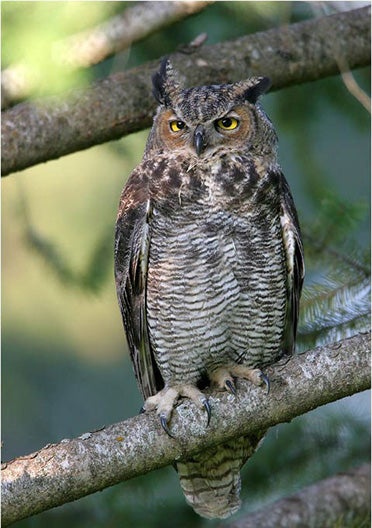Look for Great Horned Owls in Alabama
Published 11:46 am Wednesday, February 3, 2016
By EMILY D. COOK / Community Columnist
The Great Horned Owl, Bubo virginianus, is a large owl native to the Americas.
In Alabama, it is often considered the largest of the four species of owls.

The Great Horned Owl is often considered the largest of four species of owls in Alabama. (Contributed)
Adult Great Horned Owls range in size from 17 to 25 inches in length and can have a wingspan of 3 to 5 feet.
The females are typically larger than the males. Great Horned Owls are great at camouflage, due to their light coloring below with some horizontal brown markings, and darker colors above.
They have a white patch below their throat. Despite their large size, Great Horns are excellent at staying hidden during the day, as well as not being heard by prey at night while out hunting. They are stealthy.
Their “horns” are not horns or ears, simply tufts of extra feathers.
You can find Great Horned Owls in all types of habitats; they can take up residence in trees that border all manner of deciduous, coniferous and mixed forests, tropical rainforests, pampas, prairie, mountainous areas, deserts, subarctic tundra, rocky coasts, mangrove swamp forests and some urban areas.
Great Horned Owls are not picky eaters; they have an appetite for just about anything.
Their diet in North America is made up of 87.6 percent mammals, 6.1 percent birds, 1.6 percent reptiles and amphibians with the remaining 4.7 percent being made up by insects, other assorted invertebrates and fish.
They will even eat a skunk. Mice and rats make up a large portion of the rodents mammals consumed.
Many prey items are consumed whole and bones and fur are regurgitated in pellets.
Great Horns are possibly the earliest egg-laying birds known. Depending on their location, they can lay eggs as early as late November (in Southern Florida) all the way into May (in Alaska).
There are usually two eggs but can be up to six, though over three is uncommon. Incubation can last up to 37 days, but is normally about 33 days.
Because of their adaptability, Oak Mountain and the areas surrounding it are perfect places for them to live.
You can see two beautiful owls on Treetop Nature Trail or come stay a night with us in the cabins or campground and listen for these gorgeous birds.
Please remember that you keep Alabama State Parks open by visiting them. Thank you for your support.









